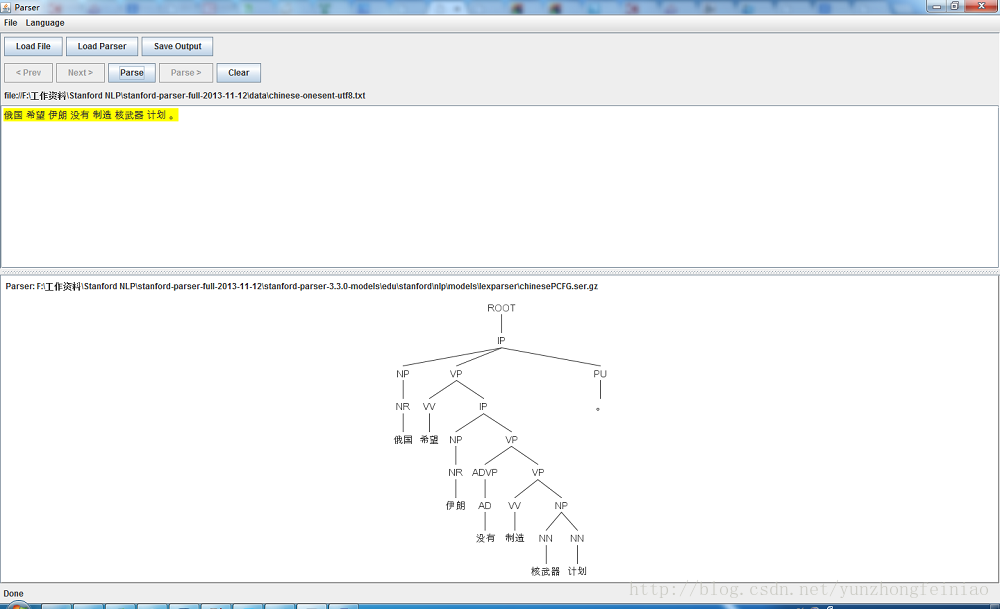Stanford Parser是由StanforsNLP Group开发的基于Java的开源NLP工具,支持中文的语法分析,当前最新的版本为3.3.0,下载地址为:http://nlp.stanford.edu/software/lex-parser.shtml。下载后解压。解压文件中lexparser-gui.bat进行可视化页面运行,解析需要的模型文件存放在stanford-parser-3.3.0-models.jar,可以对其解压,方面以后使用。在中文处理方面,提供的模型文件有chineseFactored.ser.gz、chinesePCFG.ser.gz、xinhuaFactored.ser.gz、xinhuaFactoredSegmenting.ser.gz、xinhuaPCFG.ser.gz。factored包含词汇化信息,PCFG是更快更小的模板,xinhua据说是根据大陆的《新华日报》训练的语料,而chinese同时包含香港和台湾的语料,xinhuaFactoredSegmenting.ser.gz可以对未分词的句子进行句法解析。
运行方式:
1. 命令行
没有实际操作过,不是很熟悉。
2. 图形界面
直接运行lexparser-gui.bat文件,选择Load Parser 选择上文中的模型文件,如果语句未分词应该选择具有分词功能的模型文件,然后Load File或者直接在空白区域内输入语句。
其中分词后的语句进行句法分析示例如下图所示:
未分词的句子解析后如下图所示:
3. API调用
工具同时提供了API的调用方式,在文件夹中也提供了帮助文档。具体的思路大致是:
1. 指定模型文件,指定一些参数信息。
String grammars = "edu/stanford/nlp/models/lexparser/chinesePCFG.ser.gz";2. 加载模型文件,初始化用于句法分析的类LexicalizedParser。
LexicalizedParser lp = LexicalizedParser.loadModel(grammars);3. 调用parse()方法进行解析。
Tree t = lp.parse(s);4. 后续处理,根据自己的需要生成不同的处理格式。
ChineseTreebankLanguagePack tlp = new ChineseTreebankLanguagePack();
GrammaticalStructureFactory gsf = tlp.grammaticalStructureFactory();
ChineseGrammaticalStructure gs = new ChineseGrammaticalStructure(t);
Collection<TypedDependency> tdl = gs.typedDependenciesCollapsed();我做的东西需要获取句子的主谓宾结构,但是Stanford Parser的输出结果中没发现有直接的标注主谓宾的结果,于是需要自己对于输出的语法依赖树结果处理一下。对句子词语之间的依赖关系如:[nsubj(发出-3, 国务院-1), tmod(发出-3, 日前-2), root(ROOT-0, 发出-3), amod(通知-5, 紧急-4), dobj(发出-3, 通知-5), conj(发出-3, 要求-7), det(地-9, 各-8), dobj(要球-7, 地-9), advmod(落实-11, 切实-10), dep(要求-7, 落实-11), rcmod(政策-18, 保证-12), nn(供应-14, 市场-13), dobj(保证-12, 供应-14), cpm(保证-12, 的-15), det(政策-18, 各-16), clf(各-16, 项-17), dobj(落实-11, 政策-18), dep(落实-11, 维护-20), nn(稳定-23, 副食品-21), nn(稳定-23, 价格-22), dobj(维护-20, 稳定-23)]
对于标注为dobj这样的每一个TypedDependency实体关系为直接宾语关系,然后获取实体的支配者和被支配者,遍历所有依赖关系查看支配者是否存在主语,如存在则构成一个完整的主谓宾结构,否则是一个谓语宾语结构,这种方法不是特别合理,但是暂时还没想到更好的方法。
最后附上我整理汇总的一些常用的标注指代。
ROOT:要处理文本的语句
IP:简单从句
NP:名词短语
VP:动词短语
PU:断句符,通常是句号、问号、感叹号等标点符号
LCP:方位词短语
PP:介词短语
CP:由‘的’构成的表示修饰性关系的短语
DNP:由‘的’构成的表示所属关系的短语
ADVP:副词短语
ADJP:形容词短语
DP:限定词短语
QP:量词短语
NN:常用名词
NR:固有名词
NT:时间名词
PN:代词
VV:动词
VC:是
CC:表示连词
VE:有
VA:表语形容词
AS:内容标记(如:了)
VRD:动补复合词
CD: 表示基数词
DT: determiner 表示限定词
EX: existential there 存在句
FW: foreign word 外来词
IN: preposition or conjunction, subordinating 介词或从属连词
JJ: adjective or numeral, ordinal 形容词或序数词
JJR: adjective, comparative 形容词比较级
JJS: adjective, superlative 形容词最高级
LS: list item marker 列表标识
MD: modal auxiliary 情态助动词
PDT: pre-determiner 前位限定词
POS: genitive marker 所有格标记
PRP: pronoun, personal 人称代词
RB: adverb 副词
RBR: adverb, comparative 副词比较级
RBS: adverb, superlative 副词最高级
RP: particle 小品词
SYM: symbol 符号
TO:”to” as preposition or infinitive marker 作为介词或不定式标记
WDT: WH-determiner WH限定词
WP: WH-pronoun WH代词
WP$: WH-pronoun, possessive WH所有格代词
WRB:Wh-adverb WH副词
关系表示
abbrev: abbreviation modifier,缩写
acomp: adjectival complement,形容词的补充;
advcl : adverbial clause modifier,状语从句修饰词
advmod: adverbial modifier状语
agent: agent,代理,一般有by的时候会出现这个
amod: adjectival modifier形容词
appos: appositional modifier,同位词
attr: attributive,属性
aux: auxiliary,非主要动词和助词,如BE,HAVE SHOULD/COULD等到
auxpass: passive auxiliary 被动词
cc: coordination,并列关系,一般取第一个词
ccomp: clausal complement从句补充
complm: complementizer,引导从句的词好重聚中的主要动词
conj : conjunct,连接两个并列的词。
cop: copula。系动词(如be,seem,appear等),(命题主词与谓词间的)连系
csubj : clausal subject,从主关系
csubjpass: clausal passive subject 主从被动关系
dep: dependent依赖关系
det: determiner决定词,如冠词等
dobj : direct object直接宾语
expl: expletive,主要是抓取there
infmod: infinitival modifier,动词不定式
iobj : indirect object,非直接宾语,也就是所以的间接宾语;
mark: marker,主要出现在有“that” or “whether”“because”, “when”,
mwe: multi-word expression,多个词的表示
neg: negation modifier否定词
nn: noun compound modifier名词组合形式
npadvmod: noun phrase as adverbial modifier名词作状语
nsubj : nominal subject,名词主语
nsubjpass: passive nominal subject,被动的名词主语
num: numeric modifier,数值修饰
number: element of compound number,组合数字
parataxis: parataxis: parataxis,并列关系
partmod: participial modifier动词形式的修饰
pcomp: prepositional complement,介词补充
pobj : object of a preposition,介词的宾语
poss: possession modifier,所有形式,所有格,所属
possessive: possessive modifier,这个表示所有者和那个’S的关系
preconj : preconjunct,常常是出现在 “either”, “both”, “neither”的情况下
predet: predeterminer,前缀决定,常常是表示所有
prep: prepositional modifier
prepc: prepositional clausal modifier
prt: phrasal verb particle,动词短语
punct: punctuation,这个很少见,但是保留下来了,结果当中不会出现这个
purpcl : purpose clause modifier,目的从句
quantmod: quantifier phrase modifier,数量短语
rcmod: relative clause modifier相关关系
ref : referent,指示物,指代
rel : relative
root: root,最重要的词,从它开始,根节点
tmod: temporal modifier
xcomp: open clausal complement
xsubj : controlling subject 掌控者























 3301
3301










